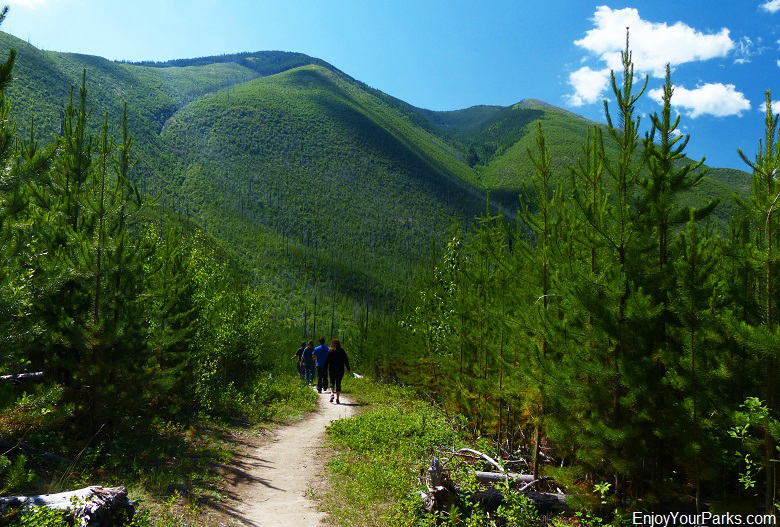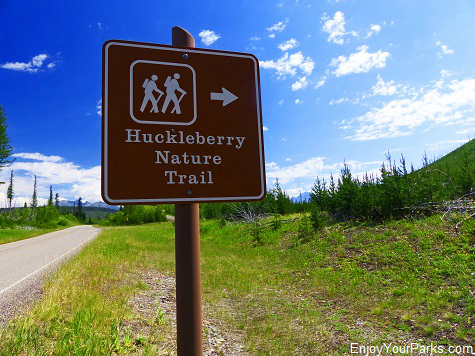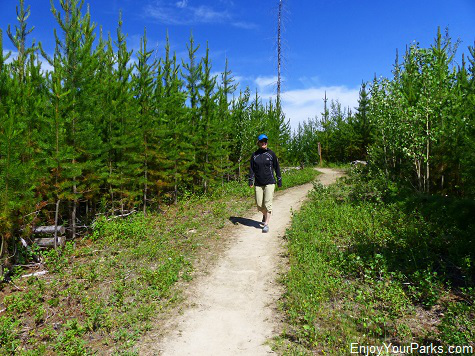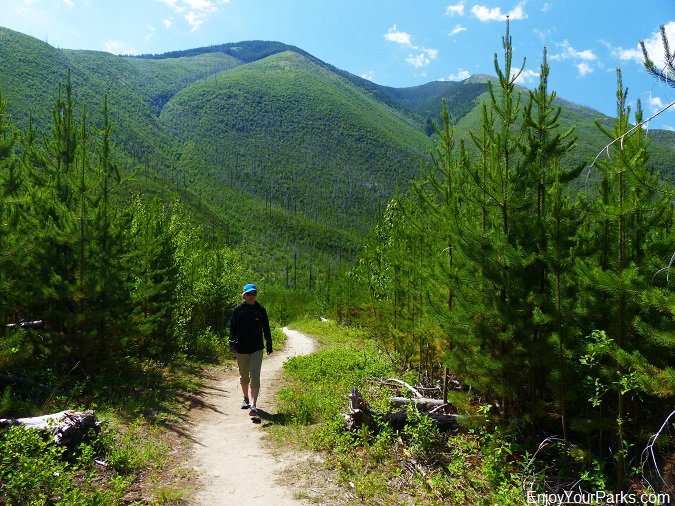Huckleberry Nature Trail

Huckleberry Nature Trail, Glacier National Park
Huckleberry Nature Trail
Trailhead: Camas Road, 0.3 miles east of Camas Creek Entrance Station
Distance: 0.9 miles (round trip loop)
Elevation Gain: 100 vertical feet
Elevation Loss: 100 vertical feet
The hike along the Huckleberry Nature Trail in Glacier National Park takes you through a very young forest, as this entire area was taken out by a forest fire over 35 years ago. You will see young lodgepole pines as well as young larch as you stroll along this pleasant Glacier National Park trail.
There is a brochure available at the trailhead that explains how forests "return" after a devastating forest fire, so we highly recommend that you take this brochure with you along your hike around the Huckleberry Nature Trail, as it will make this short Glacier Park hike a bit more interesting.
Finding The Trailhead
 The trailhead to the Huckleberry Nature Trail in Glacier National Park is located along the Camas Road, about 0.3 miles east of the Camas Creek Entrance Station.
The trailhead to the Huckleberry Nature Trail in Glacier National Park is located along the Camas Road, about 0.3 miles east of the Camas Creek Entrance Station.
There is a large trailhead sign along the side of the road, so you can't miss it. To find the Camas Road, simply drive northwest from Apgar Village towards the Polebridge Ranger Station. You are now officially on the Camas Road as you drive by the Fish Creek Campground junction. In approximately 10.7 miles from Apgar Village, you will encounter the Huckleberry Mountain Nature Trail sign to your left. If you reach the Camas Creek Entrance Station 0.3 miles further down the road, turn around because you went too far.
The Hike Along the Huckleberry Nature Trail
The hike along the Huckleberry Nature Trail in Glacier National Park is for those visitors who are interested in how forests return after a devastating forest fire. You will see mainly young lodgepole pine trees as well as young larch. Both of these types of trees are "opportunistic" when it comes to forest fires. Lodgepole pines have no protection from a forest fire, and will be killed during the blaze. However, as the fire heats up, this intense heat actually opens up the special cones (known as serotinous cones) of the lodgepole pine trees. The seeds are sealed in pitch until exposed to heat, and they will open up and re-seed the area. If it were not for the intense heat, the seeds would not have been activated.
 Larch on the other hand work things a little differently during and after a fire. Larch have a very thick, protective bark, and as the fire burns the bark, the burning bark will peel off the tree, therefore protecting the living cambrium underneath the bark. So large mature larch are often times the only tree left standing after a forest fire, and these larch have the task of re-seeding the area after the fire has passed.
Larch on the other hand work things a little differently during and after a fire. Larch have a very thick, protective bark, and as the fire burns the bark, the burning bark will peel off the tree, therefore protecting the living cambrium underneath the bark. So large mature larch are often times the only tree left standing after a forest fire, and these larch have the task of re-seeding the area after the fire has passed.
Therefore, you will see young lodgepole pines and young larch that have replenished this area, as well as fireweed, which is a fuschia-colored wildflower that tends to show up after a forest fire.
Even though there are indeed a multitude of young trees aiding in the rebirth of this forest, the hike around the Huckleberry Nature Trail illustrates to us just how short this area's growing season is, and just how long it takes for a tree to mature in this section of the country.
Along the Huckleberry Nature Trail, there are places where the trail climbs 100 vertical feet in elevation and then drops 100 feet in elevation, so even though this is regarded as one of the easier Glacier Park hikes, keep in mind that it is not completely level.

Huckleberry Nature Trail, Glacier National Park




